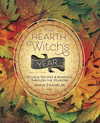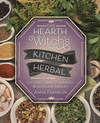Tuning in to the Wheel of the Year

People often ask me how they can better tune in to the Wheel of the Year. We all know that most modern Pagans celebrate eight Sabbats, the "high points" of the year, but there are 357 other days in the year—what about them?
Really tuning in to the Wheel of the Year means being absorbed into the whole year, and developing a deep awareness of its ever-changing energy tides. Depending on where you live, these may be very obvious or much more subtle. Here in England we have four very distinct seasons. In spring, a great flood of energy pours into the land, waking it up; green shoots push their way through the earth, birds and mammals become more active and start to mate. Then summer brings a time of flowering lushness and full growth, but in autumn, things start to slow down again as the great tide of energy recedes, and the leaves fall. In the cold, dark days of winter, the land falls asleep, holding close the fallen seeds until spring returns. Embracing the Wheel of the Year means putting aside your books and your computer screens to get out there and experience nature in its entirety, summer and winter, rain and shine, heat and cold. Away from all our twenty-first century distractions, we can begin to make real and profound spiritual connections.
If you are lucky enough to have a garden, you already have a head start and an intimate link with the seasons. In the balmy days of spring, when life returns, I begin work on the garden, planting seeds and nurturing new plants. In the full days of summer I am busy weeding and hoeing, collecting and preparing herbs and remedies to see me through the year. Then comes the abundant bounty of autumn, when all the work on the vegetable plot pays off, and I get busy preserving it, freezing and canning, making jams and wines. Finally come the frozen days of winter, when the garden sleeps and I turn my attention to indoor activities. My garden teaches me about the magic of nature as I try to understand how each plant grows and what it needs, and how to work with it so that it will give me beauty, food, ingredients for wine, dyes and magical potions, or help me with my healing work. I encourage you to try growing some plants, or even some of your own food, whether this is a whole vegetable bed, a couple of pots of tomatoes on the balcony, or some herbs on the windowsill.
If you live in a city, it is even more important to get outside into the natural world—it will benefit your physical and mental health as well as your spiritual practice. Choose a path you can walk on a regular basis, perhaps through a park or public garden, and notice the changes each time you visit. Don't let the weather put you off—the wind and the snow are Mother Nature's gifts, too. Use all your senses, not just sight, but listen and smell, feel the textures, and you can even taste if you are sure that it is safe (don't take any risks). Sit beneath a tree, become aware of its strength behind your back, its roots deep into the earth, and the rustling of its branches. Be still and open yourself to what is going on around you.
The more you notice, the better. Get a pretty notebook and keep a nature journal. Record when buds start to unfold on particular plants, when they start to flower, and when the seeds form. Notice which trees lose their leaves in winter and which don't, which plants thrive in the winter, and which die down. Record the weather, the days of sunshine, windy days, the first frost, and notice how this affects things. Note the first song of the birds in spring, their winter migrations, and the activity of wild animals, when the frogs return to the ponds, and when the first bees and butterflies visit. You can press flowers and leaves into your journal, or add your photographs and drawings. Year by year, you'll notice that things don't happen on the same day, week, or even month each time, and that sometimes the season seems late. Nature doesn't follow a written calendar, but is affected by many factors. You'll soon observe that all life is dependent on the cycle of the sun, the hours of light increasing and decreasing, and the consequent increasing and decreasing warmth of the seasons. The significant points of the solar year that are celebrated at the equinoxes and solstices, and these will become even more resonant for you when you celebrate them.
If you have children, you could collect leaves, flowers, pinecones, feathers, twigs, mosses, and acorns etc. each month and make a nature table. I suspect many of us did this in primary school, and it is a lovely way to introduce children to the gifts of each season. We adults can use the natural objects we collect to make decorations, wreaths, corn dollies, nature prints, and other crafts.
If you live somewhere you can forage for wild food, this is a wonderful way to connect with the time of year—collecting fresh salad leaves in spring, blossoms and berries in summer, fruits, nuts and seeds in autumn, and the joy of discovering that even in winter there are still treasures to be found. Go on a course or get a knowledgeable friend to guide you, so you are sure that what you are collecting is actually edible and not poisonous.
Notice the weeds in your yard or street. These much-maligned plants are often very valuable wild food and medicine. Try learning what each one can do, and how it is used. Don't try to learn everything at once, but work with one plant at a time, and really get to know it throughout the year.
Try eating only eat seasonal foods. This means buying local foods grown in your own regional environment. Being able to eat strawberries all year round might seem like a great thing, but they have to be flown in from greenhouses around the world at a high cost to the climate and planet. I only eat my home-grown strawberries in the summer, and can well do without the giant, tasteless supermarket ones in winter. It's a treat I look forward to, along with all the other goodies that only come once a year.
It's worth remembering that the ancient Pagans had many, many festivals throughout the entire year, not just eight. These marked the seasonal tides and the solar, agricultural, and pastoral cycles. For them, the cycle of the year was much more nuanced, and much more personal, since most of them worked on the land and depended on it for survival. Instead of trying to dominate nature and its shifting tides of energy, they worked in harmony with them and the Gods who oversaw the whole process—the indwelling gods and goddesses who represent the diversity of the natural world. As Pagans, when we open our souls to nature, we touch our Gods, but when we turn our backs on it, we feel a sense of alienation, of spiritual and emotional loss, because we are cut off from our divine source. This makes it vital to experience the natural world and it is a practice that will repay you with immense joy.
Lastly, it is vital that your magic echoes what is happening in the world—the tides of energy pouring into the world in spring, and out again in autumn. There is a time to receive, and a time to give back, and this is perhaps the most important thing of all.

About Anna Franklin
Related Products


is subject to certain Terms and Conditions